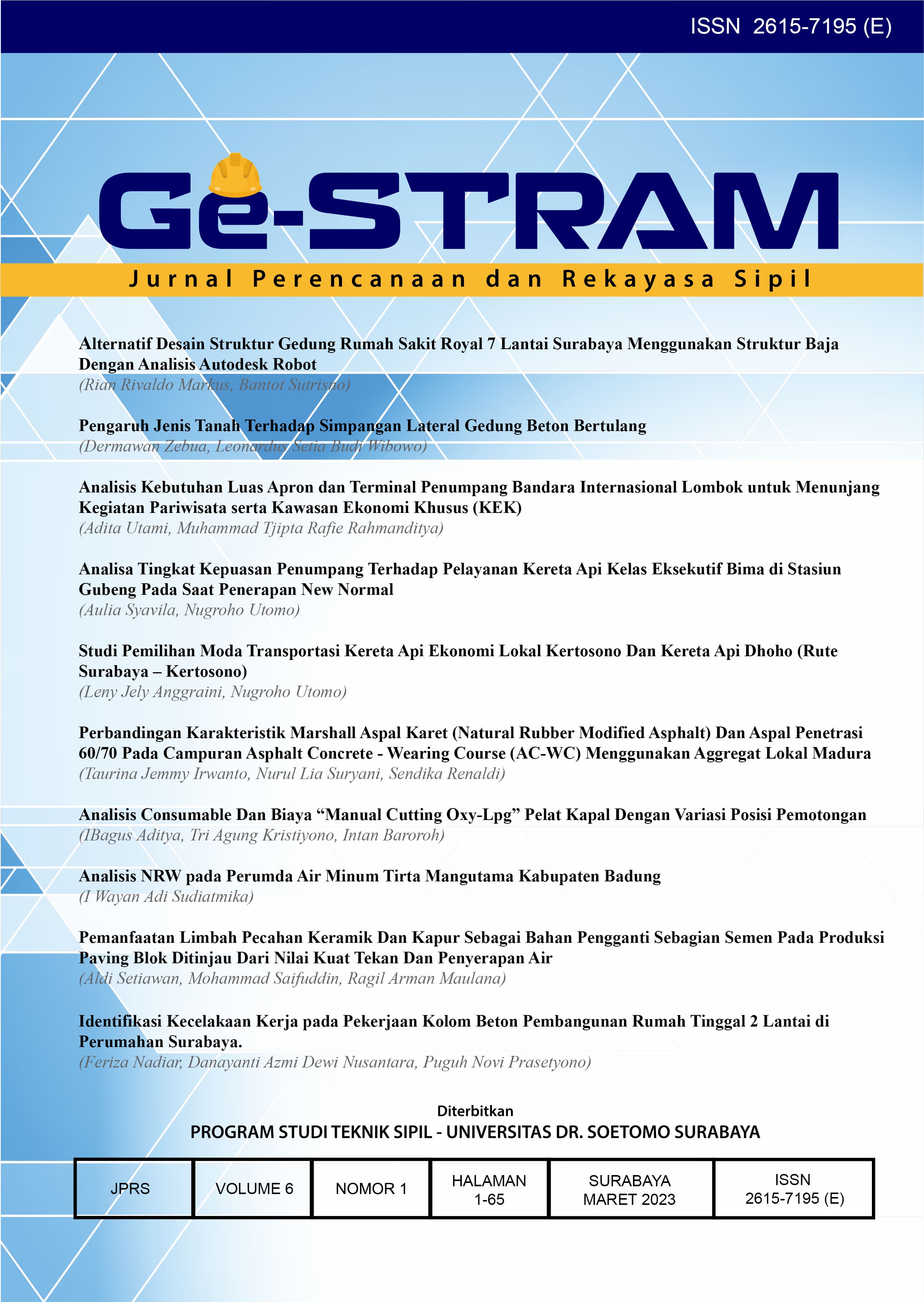Studi Pemilihan Moda Transportasi Kereta Api Ekonomi Lokal Kertosono Dan Kereta Api Dhoho (Rute Surabaya – Kertosono)
 Abstract views: 366
,
Abstract views: 366
,
 PDF downloads: 428
PDF downloads: 428
Abstract
In Indonesia, services in the transportation sector are one of the things that must be considered. Transportation services and regulations will change over time. One example of proof of service changes, especially in this pandemic era, can be shown by PT. Indonesian Railways, which has implemented all trains using AC facilities, has restricted visitors from entering stations, implemented health protocols, and brought order to street vendors. From these changes, each mode of transportation, especially the local Economy Train Kertosono and Dhoho Train, has different characteristics in terms of travel time, fares, departure times, and others. Travelers will always have their own choice of transportation mode. To find out the probability value of the selected transportation mode, it is necessary to conduct a survey of the factors that will be reviewed by travelers who use the Kertosono Local Economy Railway and Dhoho Railway to Surabaya – Kertosono transportation modes by distributing questionnaires and using the Stated Preference method.
Based on the results of research regarding the selection of transportation modes between the Kertosono Local Economy Train and the Dhoho Train which were analyzed using the Microsoft Excel program, significant results were obtained on the magnitude of the probability value of choosing a mode of transportation based on the difference in ticket prices of Rp. 2,000,- then the probability value of PKAD is 0.63 and the probability value of PKAE is 0.37. While the value of the probability of choosing a transportation mode based on the difference in travel time is -7, the probability value of PKAD is 0.65 and the probability value of PKAE is 0.35.
References
Oktavia Futri Fajarni. 2014. “Analisa Pemilihan Moda Transportasi Untuk Perjalanan Kerja (Studi Kasus : Kelurahan Mabar, Medan Deli)”. Jurnal Teknik Sipil USU Vol.3 No.1.
Al Muntsari Daud Rosyid Rahardjo, Willy Kriswardhana, Akhmad Hasanuddin. 2021. “Analisis Pemilihan Moda Transportasi Penumpang Antara Bus Dan Kereta Api Rute Surabaya - Jakarta”. Jurnal Teknik Sipil Vol.10 No.1.
Wulansari Dwi Novi. 2016. “Kompetisi Pemilihan Moda Angkutan Penumpang Berdasarkan Model Logit-Binomial-Selisih Dan Logit – Binomial – Nisbah”. Jurnal Fropil Vol.4 No.1.
Sihite Suparta, Medis Sejahtera Surbakti. 2015. “Kajian Pemilihan Moda Transportasi Antara Angkutan Kota Dengan Monorel Menggunakan Metode Stated Preference (Studi Kasus : Rencana Pembangunan Monorel Kota Medan)”. Jurnal Sipil Statik Vol.3 No.1.
Meylisa Herlyn, Amirotul MHM, Dewi Handayani. 2017. “Pemilihan Moda Angkutan Kereta Api Kalijaga Jurusan Solo - Semarang”. e-Jurnal Matriks Teknik Sipil.
Suyuti Rusmadi. 2013. “Analisis Pemilihan Moda Transportasi Antara Kereta Api Kelas Eksekutif Dengan Pesawat Udara (Studi Kasus: Rute Jakarta – Solo)”. Jurnal Seminar Nasional III Teknik Sipil.
Rahmawati Ainun, Hastarini Dwi Atmanti. 2014. “Analisis Pemilihan Moda Sepeda Motor Dan Krlcommuterline Untuk Perjalanan Kerja Ke Propinsi Dki Jakarta”. Diponegoro Journal Of Economics Vol.3 No.2.
Simanjuntak Rizyak Wale. 2013. “Analisa Pemilihan Moda Transportasi Medan-Rantau Prapat Dengan Menggunakan Metode Stated Preference”. Jurnal Teknik Sipil USU Vol.2 No.1.
Djoeddawi Andi Hadid Septi Nugraha, M. Ruslin Anwar, Rahayu Kusumaningrum. 2014. “Model Pemilihan Moda Antara Kereta Api Dan Bus Rute Makassar – Parepare Dengan Menggunakan Metode Stated Preference”. Jurnal Mahasiswa Jurusan Teknik Sipil Vol.1 No.2.
Sugiyono, Wibowo. 2004. “Buku Statistika Untuk Penelitian”.
Tamin Ofyar Z. 2000. “Perencanaan dan Permodelan Transportasi”.
Copyright (c) 2023 LENY JELY ANGGRAINI, NUGROHO UTOMO

This work is licensed under a Creative Commons Attribution-ShareAlike 4.0 International License.
Authors who publish with this journal agree to the following terms:
- Authors retain copyright and grant the journal right of first publication with the work simultaneously licensed under a Creative Commons Attribution-ShareAlike 4.0 International License that allows others to share the work with an acknowledgement of the work's authorship and initial publication in this journal.
- Authors are able to enter into separate, additional contractual arrangements for the non-exclusive distribution of the journal's published version of the work (e.g., post it to an institutional repository or publish it in a book), with an acknowledgement of its initial publication in this journal.
- Authors are permitted and encouraged to post their work online (e.g., in institutional repositories or on their website) prior to and during the submission process, as it can lead to productive exchanges, as well as earlier and greater citation of published work (See The Effect of Open Access).

This work is licensed under a Creative Commons Attribution-ShareAlike 4.0 International License.















